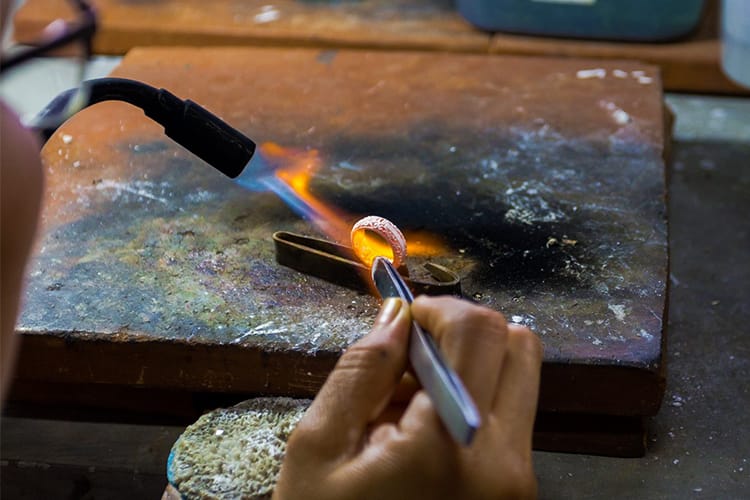Jewelry Making Methods

If you know how an item of jewelry was made, describing the process can help customers appreciate its quality and value. Dozens of specialized techniques are used today, but most involve one of four basic methods – die-striking, electroforming, casting, or hand fabrication.
Die-striking or stamping
Items are mass-produced by shaping solid metal with a mold, or die, made from hardened steel. The mold has two parts, and the form of the finished piece is defined by the interior space that’s created when those parts are joined. (The principle is similar to making Play-Doh shapes with a toy mold.) During production, sheets of precious metal alloy are placed in the mold and machine-stamped. The tremendous pressure – many tons per square inch – actually forces the metal’s atoms closer together, increasing its density and strength.
Coins are familiar die-struck objects from everyday life. Entire items of jewelry, such as wedding bands, can be manufactured this way. More often, however, die-struck pieces are made as components that are later assembled. Hollow jewelry is frequently made by stamping two separate pieces and then soldering them together. The individual panels of some link-style bracelets are also stamped. Because of the strength this process gives the metal, die-striking is a good way to make ring shanks and diamond settings (specifically, the parts called setting heads).
Electroforming
In this process, particles of precious metal alloy are electrodeposited on a model. The model is usually made from wax and then coated with graphite so it conducts electricity. It’s connected to the negative terminal of a power source and placed in a chemical solution, or bath, that contains positively charged atoms of the alloy metals. Another conductor attached to the positive terminal also goes in the bath. When the power is turned on, the model attracts the metal atoms. Metal accumulates on the model and builds a shell. After the shell is thick enough, the piece is removed, a tiny hole is drilled, and the piece is heated, causing the wax to melt and run out. The resulting jewelry is hollow and lightweight but strong. For this reason, electroforming is a common method for manufacturing large earrings, necklaces, and pins.
Casting
Jewelry is made by pouring or injecting molten metal into a mold and allowing it to cool. The process begins with carving a model from wax and imbedding it in a liquid plaster-like material called investment. After the investment solidifies, it’s heated in a high-temperature furnace to vaporize the wax and leave a hollow mold. (Because the wax disappears, this method is known as lost-wax casting.) The mold is then filled with melted metal that hardens into the form of the original model.
Casting is the most popular way to create custom-made jewelry, and it can be adapted for large-scale production as well. Models can be duplicated by making a rubber mold of a metal prototype and then using that to generate wax copies. To produce multiple castings, a number of models can be attached to a central wax rod (or sprue), forming a “tree.” The tree is then cast like an individual piece.
Hand fabrication
Each item is made completely by hand labor and manually controlled methods. Hand fabrication starts with precious metal that has undergone minimal processing. It may have been alloyed and made into bulk stock such as sheets, strips, tubes, or wire; otherwise, it is raw material. The jewelry maker then beats, bends, draws, drills, files, or saws the entire piece or separates components into the desired shapes and, if necessary, solders components together.
Hand fabrication is the oldest jewelry-making method, and many of its tools and processes originated with the earliest civilizations. It can produce almost any form or style of jewelry, but each piece is one-of-a-kind. Even if a piece copies an existing design, there are bound to be slight differences that make it unique. Under FTC guidelines, to be called “handmade” or “handwrought,” jewelry must be manufactured in this way.
Many jewelry items are assembled from components made by different methods. For instance, a ring might have a die-struck head attached to a cast shank. You can tell customers that the purpose of this “mixing and matching” is to achieve the best combination of beauty, durability, and value.
You may also need to explain that the individual labor effort that goes into the piece is a significant cost factor. Diamond setting is a prime example. Although quality setting is always critical, styles like pavé, channel, and invisible setting are very labor-intensive. Dozens of diamonds must be matched for size and appearance, and each must be set with skilled attention. Tension setting demands extra time and care as well.
Different production methods also represent differing amounts of individual work. Die-striking and large-scale electroforming and casting are industrial in nature. That’s not necessarily a negative, though. Mass production requires creativity, expertise, and effort while spreading the expense of these over a large number of items, reducing the cost of each unit. Custom-designed cast or hand-fabricated jewelry offers uniqueness, but each piece must bear the entire cost of the process. Realistically, custom-made jewelry will always be more expensive than comparable mass-produced items.
For most customers, any jewelry-making method can produce excellent results. What counts is the skill and care with which it’s done.
Source: Diamond Council of America Diamonds Course